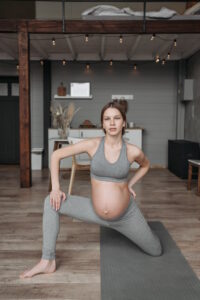
The journey of pregnancy is a remarkable one, and staying active during this time can greatly benefit both you and your growing baby. Pilates, with its focus on core strength, flexibility, and balance, can offer a safe and effective way to maintain your fitness throughout your pregnancy journey. However, as your body changes, so do the exercises that are suitable for each trimester. In this guide, we’ll explore safe Pilates exercises tailored to different stages of pregnancy, ensuring your well-being and comfort every step of the way.
What Pilates Moves to Avoid When Pregnant?
Pilates is generally safe during pregnancy, but there are specific moves that should be avoided, particularly as your pregnancy progresses. Exercises that involve lying flat on your back after the first trimester can potentially reduce blood flow to the baby due to pressure on a major vein. Deep backbends and movements that strain the abdominal muscles should also be approached with caution. Additionally, any exercises that cause discomfort, pain, or feelings of instability should be omitted. Always prioritize your comfort and safety, and communicate openly with your instructor about your pregnancy.
Can You Do Pilates Throughout Pregnancy?
Yes, Pilates can be practiced throughout your pregnancy journey, with proper modifications and guidance. In fact, many pregnant women find Pilates to be a gentle and effective way to stay active and maintain their core strength. However, it’s crucial to listen to your body and adjust your routine as needed. As your body changes, your center of gravity shifts, and your ligaments loosen, requiring modifications to ensure your safety. Consulting with your healthcare provider and working with a certified prenatal Pilates instructor can provide you with the guidance needed to enjoy Pilates safely throughout all trimesters.
Is Pilates Safe in Third Trimester?
Pilates can indeed be safe in the third trimester, but it’s essential to be cautious and focus on exercises that accommodate your changing body. By the third trimester, your belly is larger, your balance may be affected, and you might experience more discomfort. Therefore, it’s wise to opt for exercises that maintain your stability, such as seated or side-lying movements. These can help you engage your core and stay active without putting excess strain on your abdominal area. Always prioritize comfort and avoid exercises that cause discomfort or difficulty.
Can You Do Reformer Pilates in Second Trimester?
Reformer Pilates, which involves the use of specialized equipment, can be a wonderful way to engage your muscles during pregnancy, particularly in the second trimester. The support provided by the equipment can help you maintain proper alignment and reduce the risk of overexertion. However, just like with mat Pilates, modifications are key. Avoid exercises that involve lying flat on your back, and opt for positions that are comfortable and stable. As with any exercise, consulting with your healthcare provider and working with a certified instructor who understands prenatal modifications is crucial.
Summarizing the Answers
Pilates offers a safe and effective way to stay active during pregnancy, with appropriate modifications for each trimester. While certain moves should be avoided, Pilates can be practiced throughout pregnancy under the guidance of a certified prenatal instructor. In the third trimester, focusing on stability and comfort is important, and Reformer Pilates can be a suitable option in the second trimester with proper adjustments. Remember that every pregnancy is unique, so listening to your body and consulting your healthcare provider are essential. By embracing safe Pilates exercises, you’re nurturing your well-being and preparing for the incredible journey of motherhood with strength and grace.